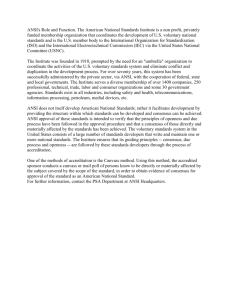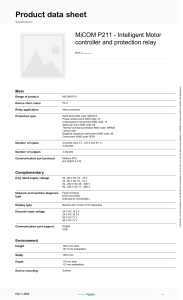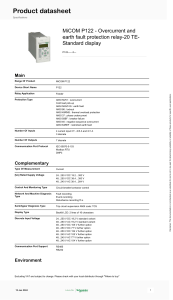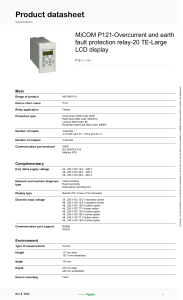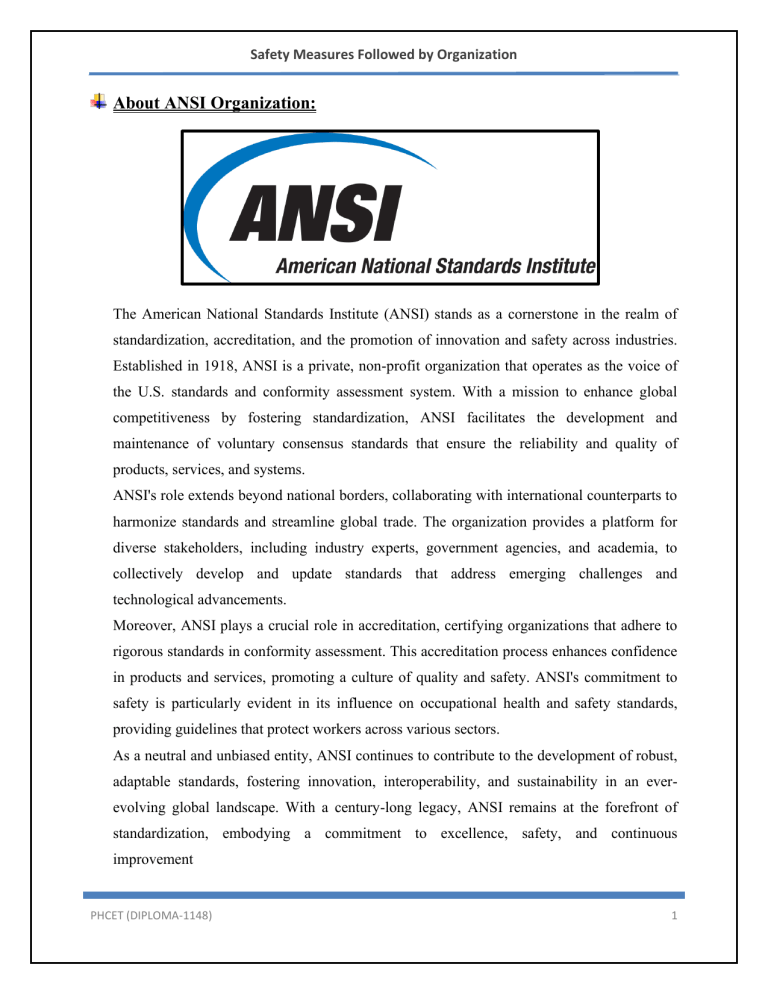
Safety Measures Followed by Organization About ANSI Organization: The American National Standards Institute (ANSI) stands as a cornerstone in the realm of standardization, accreditation, and the promotion of innovation and safety across industries. Established in 1918, ANSI is a private, non-profit organization that operates as the voice of the U.S. standards and conformity assessment system. With a mission to enhance global competitiveness by fostering standardization, ANSI facilitates the development and maintenance of voluntary consensus standards that ensure the reliability and quality of products, services, and systems. ANSI's role extends beyond national borders, collaborating with international counterparts to harmonize standards and streamline global trade. The organization provides a platform for diverse stakeholders, including industry experts, government agencies, and academia, to collectively develop and update standards that address emerging challenges and technological advancements. Moreover, ANSI plays a crucial role in accreditation, certifying organizations that adhere to rigorous standards in conformity assessment. This accreditation process enhances confidence in products and services, promoting a culture of quality and safety. ANSI's commitment to safety is particularly evident in its influence on occupational health and safety standards, providing guidelines that protect workers across various sectors. As a neutral and unbiased entity, ANSI continues to contribute to the development of robust, adaptable standards, fostering innovation, interoperability, and sustainability in an everevolving global landscape. With a century-long legacy, ANSI remains at the forefront of standardization, embodying a commitment to excellence, safety, and continuous improvement PHCET (DIPLOMA-1148) 1 Safety Measures Followed by Organization Safety Measures Followed By ANSI 2.1. Introduction to Construction Safety: Construction sites are dynamic environments where the convergence of heavy machinery, diverse tasks, and multiple personnel introduces inherent risks. Prioritizing safety is paramount to mitigate potential hazards and ensure the well-being of workers. The American National Standards Institute (ANSI) plays a pivotal role in shaping construction safety measures. The following key safety practices endorsed by ANSI underscore the commitment to creating a secure environment for construction personnel. • Personal Protective Equipment (PPE): Ensuring the use of appropriate PPE, including helmets, gloves, and safety glasses, acts as a foundational measure to protect workers from potential head injuries, hand-related risks, and eye hazards. ANSI standards guide the meticulous selection and utilization of PPE, fostering a culture of proactive risk mitigation. • Training Programs: Comprehensive training programs are imperative for empowering construction personnel with the knowledge and skills to navigate potential hazards. ANSI's emphasis on training ensures that workers are well-versed in construction site safety protocols, contributing to a proactive safety culture PHCET (DIPLOMA-1148) 2 Safety Measures Followed by Organization • Equipment Inspection: Regular inspection and maintenance of construction equipment are integral to safe operations. ANSI standards advocate for stringent inspection protocols, emphasizing the importance of identifying and addressing equipment issues promptly to prevent accidents and malfunctions. • Emergency Response Plans: Developing and implementing emergency response plans is a crucial aspect of construction safety. ANSI guidelines guide the creation of robust plans that address potential hazards, ensuring swift and effective responses to emergencies, further safeguarding the well-being of construction personnel. PHCET (DIPLOMA-1148) 3 Safety Measures Followed by Organization 2.2 Ladder Safety: Ladders, ubiquitous tools in various industries, become potential sources of accidents if not used with care. Ensuring the safety of individuals working at heights is paramount, and the American National Standards Institute (ANSI) sets the standard for safe ladder practices. Emphasizing a comprehensive approach, ANSI guidelines promote the following key ladder safety measures: • Proper Placement: Placing ladders on stable and level surfaces is the foundational step in ladder safety. ANSI underscores the importance of ensuring a secure base, minimizing the risk of the ladder tipping or slipping during use. • Weight Limitations: Communicating and enforcing weight limitations for ladders is a crucial preventive measure. ANSI standards provide clear weight capacity guidelines for different ladder types, preventing overloading and maintaining structural integrity. PHCET (DIPLOMA-1148) 4 Safety Measures Followed by Organization • Inspection: Regular inspection of ladders is an ongoing commitment to safety. ANSI recommends frequent checks for signs of damage or wear, including visual assessments for cracks, bent rungs, or any compromised components. Timely identification of issues ensures the removal of unsafe ladders from service. • Usage Guidelines: Providing clear guidelines on the correct usage of ladders is an essential aspect of ladder safety. ANSI emphasizes proper climbing techniques, maintaining three points of contact, and avoiding overreaching. Training programs based on these guidelines contribute to a safer working environment. PHCET (DIPLOMA-1148) 5 Safety Measures Followed by Organization 2.3 Fall Protection Safety: Fall Protection Safety is a critical aspect of ensuring the well-being of workers engaged in tasks at elevated work areas. Falls from heights can result in severe injuries or even fatalities, making it imperative for organizations to prioritize and implement robust safety measures. Employers must be proactive in establishing comprehensive fall protection strategies to mitigate the risks associated with working at heights. Effective fall protection safety measures, aligned with ANSI guidelines, are essential for creating a secure environment. Organizations must invest in continuous training, equipment implementation, and adherence to standards to safeguard workers from potential fall-related hazards, fostering a culture of proactive safety awareness. • Guardrails and Barriers: One fundamental approach to fall protection involves the installation of guardrails and barriers at elevated work areas. These physical barriers create a protective boundary, preventing accidental falls and providing a visible indication of the workspace's limits. Properly designed and installed guardrails play a crucial role in enhancing workplace safety and reducing the likelihood of accidents. PHCET (DIPLOMA-1148) 6 Safety Measures Followed by Organization • Personal Fall Arrest Systems (PFAS): In situations where guardrails and barriers may not be feasible or sufficient, Personal Fall Arrest Systems (PFAS) becomes essential. PFAS consists of a harness, lanyard, and anchor point, working together to arrest a fall and minimize the impact on the worker. Proper implementation and usage of PFAS are vital to safeguarding workers who are at risk of falling, ensuring that they are protected while working at heights. • Training: A key component of an effective fall protection program is comprehensive training. Workers must be adequately educated on the potential hazards associated with working at heights, as well as the proper usage of safety equipment such as harnesses and lanyards. Training programs should also cover the importance of recognizing and reporting unsafe conditions, fostering a safety-conscious culture among all personnel. • Anchorage Points: The reliability of fall protection systems heavily depends on secure anchorage points. Employers must ensure that anchorage points are strategically located and structurally sound to support the forces generated during a fall. Regular inspections and maintenance of these anchorage points are imperative to guarantee their continued effectiveness in preventing accidents. PHCET (DIPLOMA-1148) 7 Safety Measures Followed by Organization 2.4 Clothing and Equipment Safety: In workplaces where potential hazards are a reality, prioritizing the safety of personnel through proper clothing and equipment is paramount. The American National Standards Institute (ANSI) plays a crucial role in establishing guidelines to ensure the well-being of workers. The following practices endorsed by ANSI emphasize the importance of clothing and equipment safety, fostering a secure environment for individuals engaged in diverse job tasks. • Appropriate Attire: ANSI underscores the significance of specifying and enforcing the use of appropriate clothing tailored for different job tasks. This practice not only enhances safety but also ensures that workers are equipped to tackle specific workplace challenges, minimizing risks associated with their attire. • Safety Gear: Providing and mandating the use of safety gear, including essentials such as hard hats and steeltoed boots, is fundamental in ANSI's approach to clothing and equipment safety. These protective measures are tailored to mitigate risks associated with head injuries and foot-related hazards. PHCET (DIPLOMA-1148) 8 Safety Measures Followed by Organization • Fit and Comfort: ANSI guidelines emphasize the importance of ensuring that safety clothing and equipment are not only effective but also properly fitted and comfortable for workers. Comfortable gear enhances compliance and ensures that individuals can carry out their tasks without compromising their safety. • Regular Inspections: The commitment to clothing and equipment safety extends to regular inspections. ANSI recommends the routine examination of safety clothing and equipment to identify any signs of damage or wear. Timely inspections enable the replacement of damaged or worn-out items, maintaining the efficacy of safety measures. PHCET (DIPLOMA-1148) 9 Safety Measures Followed by Organization 2.5 Workplace Surfaces Safety: In the dynamic landscape of workplaces, the safety of surfaces is integral to preventing accidents and ensuring the well-being of employees. The American National Standards Institute (ANSI) plays a pivotal role in establishing guidelines that enhance workplace surfaces safety. Addressing potential risks associated with flooring and surfaces, the following ANSI-endorsed practices are fundamental to creating secure environments for workers. • Slip-resistant Flooring: ANSI emphasizes the implementation of slip-resistant flooring, especially in areas prone to wet or slippery conditions. This proactive measure minimizes the risk of slips and falls, offering a stable foundation for employees to navigate their work environments safely. • Proper Lighting: Adequate lighting is paramount in identifying potential hazards on surfaces. ANSI guidelines stress the importance of ensuring proper illumination to enhance visibility, enabling employees to detect and navigate around obstacles or potential dangers effectively. PHCET (DIPLOMA-1148) 10 Safety Measures Followed by Organization • Clear Signage: Clear signage serves as a crucial communication tool in workplace surfaces safety. ANSI recommends the use of visible signage to indicate potential risks and provide essential safety precautions. This practice contributes to a heightened awareness among employees, fostering a culture of vigilance. • Regular Maintenance: Regular maintenance of workplace surfaces is central to preventing hazards. ANSI guidelines advocate for routine inspections and upkeep to identify and address issues promptly. Whether addressing uneven surfaces or potential tripping points, regular maintenance is key to sustaining a safe working environment. PHCET (DIPLOMA-1148) 11 Safety Measures Followed by Organization 2.6 Occupational Health and Safety: In the pursuit of creating workplaces that prioritize the well-being of employees, Occupational Health and Safety (OHS) measures are indispensable. The American National Standards Institute (ANSI) plays a crucial role in shaping guidelines that safeguard the health of workers. Within the realm of OHS, ANSI endorses practices that contribute to the overall health and safety of employees exposed to occupational hazards. The following ANSI-supported measures underscore the commitment to creating work environments that prioritize the long-term wellbeing of the workforce. These health assessments, in alignment with ANSI standards, serve as a crucial tool in systematically evaluating the well-being of workers, identifying potential occupational hazards, and facilitating targeted preventive measures to safeguard employee health in dynamic work environments. • Health Assessments: ANSI advocates for the regular conduct of health assessments for workers exposed to specific occupational hazards. These assessments provide insights into potential health risks, enabling proactive measures to mitigate or prevent adverse health effects. PHCET (DIPLOMA-1148) 12 Safety Measures Followed by Organization • Chemical Safety: The implementation of measures to control and minimize exposure to hazardous chemicals is fundamental in ANSI's approach to OHS. Guidelines endorsed by ANSI focus on creating a safe environment where the handling, storage, and disposal of chemicals align with stringent safety standards. • Ergonomic Design: ANSI emphasizes the importance of ergonomic considerations in designing workspaces to prevent musculoskeletal issues. This approach involves creating environments that promote proper posture, reduce strain, and enhance overall comfort, contributing to the prevention of workplace-related physical stress. • Wellness Programs: ANSI-endorsed wellness programs play a vital role in promoting overall health and preventing occupational illnesses. These programs are designed to address various aspects of well-being, including physical health, mental health, and lifestyle choices, fostering a holistic approach to employee welfare. PHCET (DIPLOMA-1148) 13 Safety Measures Followed by Organization Result The implementation of ANSI safety measures yields multifaceted results that significantly impact the overall safety and well-being of workers. Firstly, adherence to ANSI guidelines results in a tangible reduction in accidents. The meticulous standards and protocols provided by ANSI contribute to a safer work environment, minimizing the occurrence of incidents that could lead to injuries or fatalities. Additionally, ANSI safety measures foster a proactive safety culture within organizations. The emphasis on comprehensive training programs ensures that employees are well-informed about potential hazards and equipped with the knowledge to prevent accidents. This culture permeates daily operations, creating a heightened awareness of safety considerations at all levels of the workforce. Organizations following ANSI guidelines benefit from enhanced workplace safety, not only minimizing risks but also prioritizing the health and well-being of their workforce. Regular equipment inspections and maintenance, as recommended by ANSI, contribute to the longevity and reliability of tools and protective gear, ensuring they are in optimal condition. Furthermore, ANSI safety measures contribute to the mitigation of occupational health risks. Health assessments, ergonomic considerations, and chemical safety measures endorsed by ANSI work in tandem to prevent long-term health issues, creating a healthier and more sustainable workforce. In summary, the results of implementing ANSI safety measures encompass a safer work environment, a proactive safety culture, reduced accidents, and an overall improvement in the health and well-being of the workforce, positioning organizations for sustained success in the long run. PHCET (DIPLOMA-1148) 14 Safety Measures Followed by Organization Conclusion The American National Standards Institute (ANSI) emerges as a stalwart guardian of workplace safety, shaping a landscape where security and well-being take center stage. ANSI's pivotal role in the establishment and dissemination of safety measures cements its status as a cornerstone for organizations worldwide. The dedication to developing and promoting stringent safety standards underscores a commitment that extends beyond compliance – it's a commitment to fostering a global culture of safety consciousness. ANSI's influence resonates in workplaces where employees not only perform their tasks but thrive in environments designed to prioritize their safety. In navigating the dynamic challenges of today's working world, ANSI's continued commitment remains indispensable for cultivating not just secure, but healthier and more productive workplaces. At the heart of ANSI's impact is the recognition that safety is not merely a regulatory requirement; it is a fundamental value that defines organizational excellence. ANSI's meticulous approach to safety standards, innovative practices, and comprehensive training programs set the gold standard, inspiring other entities to elevate their safety protocols. The organization's influence extends beyond its immediate sphere, serving as a catalyst for a broader cultural shift towards safety consciousness. ANSI's commitment is not static; it evolves with the ever-changing dynamics of workplaces and emerging challenges. The organization's forward-thinking approach is evident in its embrace of innovative technologies, proactive risk mitigation strategies, and a holistic view of employee well-being. As a result, ANSI stands not only as a symbol of safety but as a dynamic force driving continuous improvement in workplace health and security. PHCET (DIPLOMA-1148) 15
